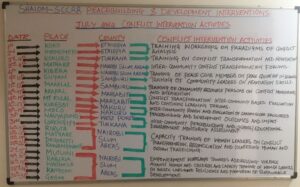
A group of stakeholders in Kokuro with Shalom’s facilitators after the training.
By Paulson Erot, MA
Ethiopia and Kenya share a 600-km border that extends from Somalia in the east to South Sudan in the west. The vast majority of people living in Southern Ethiopia and Northern Kenya are pastoralists who move with their livestock in response to resource fluctuation and availability. The nomadic lifestyle of these people makes them particularly vulnerable to the risk of conflict. Most of these pastoralists rely heavily on their cattle for survival and warfare often originates when one group raids another. This remains a major negative intervening factor towards peace in the region.
Shalom’s quest has always been “Working to End the Cycle of Violence in the Tribal Lands of Eastern Africa.” Driven by this overall goal, Shalom’s team travelled,for the first time to Kokuro, an informal town in Kibish sub-county in Turkana County. It is right in the heart of the highly disputed Ilemi Triangle where various states and ethnic groups compete for resources. Specifically, Kokuro it is about 30 km from the Kenyan-Ethiopian border and is approximately 370 km from Lodwar town, the major formal town and headquarters of the County. The residents of the area are exclusively from the Turkana community who are in conflict with Merille and Nyang’atom (Dong’iro) communities from Ethiopia. Unfortunately, recurrent or persistent conflict has become part and parcel of existence. The objective of this training was in line with SCCRR’s approach of entering and working in the African conflict zones setting people on the paths to peaceful and reconciled communities.
Through the workshops conducted in the area in October 2015, Shalom was able to begin addressing significant causes of conflict between the Turkana, Merille and Nyang’atom communities; the interventions done by various state and non-state actors; and, the challenges encountered in the process of bringing peace between these rivalry ethnic communities bordering each other.
The participants articulated various causes of conflict between these pastoralist communities: livestock rustling; pasture (grazing fields); water; fulfillment of cultural practices; and insecurity. Livestock is the mainstay of the pastoralist communities since it is their source of food, bride price, income, wealth, a social status symbol, as well as insurance against life’s risks and the foundation of a community’s entire livelihood. Historically, the Turkana and the Merille have always engaged in livestock raids and counter-raids (revenge-motivated) to accumulate more and more herds of animals. Water and pasture are the other two vital resources that have triggered conflicts between the two communities. Although this volatile border is rich in pasture and water, each of these important resources is often only available on one side of the border. While the Ethiopian side is blessed with water from the seasonal river Nakuwa, the Kenyan side is rich in pasture. This leaves each of the community vulnerable as they seek the missing resource across the international border.
A further complication is that the Merille and Nyang’atom practice circumcision as a rite of passage while the Turkana do not. As part of their culture and tradition, the Merille and the Nyang’atom youth are required to combat their ‘enemies’ from Turkana in order to graduate to become real ‘men’ after their circumcision ceremony. This practice has always triggered conflict between these bordering communities. Insecurity is another vice that makes this area vulnerable to intractable conflicts. Lack of security in this volatile area, has made many residents to acquire guns as a source of both self-security and livelihood. Therefore, this has led to the increase in the proliferation of small arms and light weapons in this area which has resulted in more frequent attacks and counter-attacks between these communities.
Although efforts have been made to bring to an end to this conflict, the conflict is still on-going. Past interventions by the Kenyan and the Ethiopian governments (which is normally minimal), various NGOs and the local communities’ leaders have not had significant impact. Many people are still being maimed, killed, injured, displaced, livestock driven away and the residents are always living in tension of looming attacks.
One of the most noticeable challenges to the management and resolution of this conflict is inadequate knowledge and skills of peacebuilding amongst the major stakeholders in the conflict. Due to the existence of this gap, local administrators and religious leaders requested Shalom to build the capacity of these stakeholders with peace-building techniques. During the October 2015 workshop, SCCRR formed a working community group comprised of local administrators; religious leaders; traditional leaders; women leaders; and, youth leaders in Kokuro. This group will be taken through a series of trainings that will equip them with technical and analytical skills on conflict prevention, management, transformation and resolution. The idea is to enable these local stakeholders (key opinion shapers) to be the architects of their own futures from the grassroots up. Endurable peace cannot be imposed from the top down. These opinion shapers will be instrumental in addressing this intractable conflict and promoting peace in this area, just like their SCCRR’s counterparts in Nairobi, Nakuru, Samburu, West Pokot and Marsabit Counties in the country.

